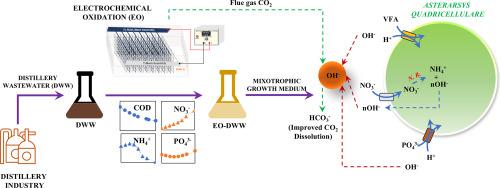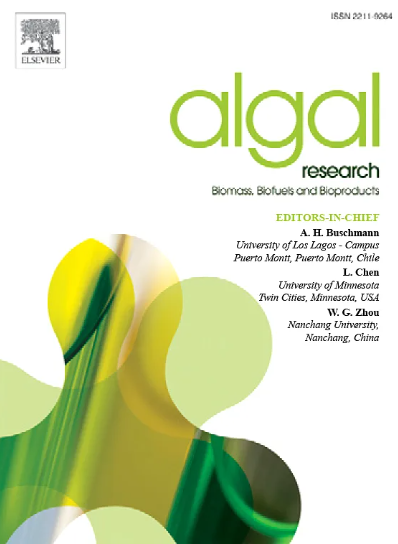Enhancing nutrient bioavailability in distillery wastewater through electrochemical oxidation for microalgal growth: Insights on biomass yield, nutrient utilisation, and VFA-assisted carbon capture
IF 4.6
2区 生物学
Q1 BIOTECHNOLOGY & APPLIED MICROBIOLOGY
Algal Research-Biomass Biofuels and Bioproducts
Pub Date : 2024-10-01
DOI:10.1016/j.algal.2024.103734
引用次数: 0
Abstract
Two-stage treatment of distillery wastewater (DWW) via electrochemical oxidation (EO) using Ti-RuO2 anodes (35 cm2 area) followed by mixotrophic microalgal treatment was investigated. In the first-stage, EO of DWW has improved the bioavailability of nitrogen and phosphorus at 3.95–5.14 mg/Ah and 0.43–1.02 mg/Ah, respectively, which had strong correlation with current density. EO also reduced ∼30 % TOC, 53 % COD and ∼44 % TN. In the second-stage, the ability of a novel microalgae, Asterarsys quadricellulare to mitigate the toxicity of electrochemically oxidised DWW (EO-DWW) while utilising the nutrients effectively was investigated. The mixotrophic algal growth effectively utilised 85 % phosphate and 91 % nitrate present in EO-DWW at a corresponding growth rate of 0.73 d−1. The algal biomass was found to have ∼15 % carbohydrates, ∼12 % lipids and ∼33 % proteins. Subsequently, a bench-scale bubble column photobioreactor investigation was carried out to understand the carbon dynamics during the growth of Asterarsys quadricellulare. The metabolic uptake of monocarboxylic volatile fatty acids (VFA) and nitrate were found to release OH− ions, which eventually helped in dissolving CO2 in the reactor through a diffusion-limited process. The total energy spent in bench-scale EO system was 840 kWh (3024 kJ) per L of DWW, and the energy recovery potential of second-stage algal reactor was ∼8.7 %. The microtoxicity experiments with Alivibrio fischeri revealed that two-stage treated DWW was found to be safe for reuse as the microalgal growth has abated the toxicity of EO-DWW.

通过电化学氧化促进微藻生长,提高酒厂废水中营养物质的生物利用率:生物质产量、养分利用和 VFA 辅助碳捕获的启示
研究人员使用 Ti-RuO2 阳极(面积为 35 cm2)对酒厂废水进行了两阶段电化学氧化(EO)处理,然后进行混养微藻处理。在第一阶段,DWW 的电化学氧化提高了氮和磷的生物利用率,分别为 3.95-5.14 mg/Ah 和 0.43-1.02 mg/Ah,这与电流密度密切相关。环氧乙烷还降低了 30 % 的 TOC、53 % 的 COD 和 44 % 的 TN。在第二阶段,研究了新型微藻 Asterarsys quadricellulare 在有效利用营养物质的同时减轻电化学氧化 DWW(EO-DWW)毒性的能力。混养藻类的生长有效利用了 EO-DWW 中 85% 的磷酸盐和 91% 的硝酸盐,相应的生长率为 0.73 d-1。藻类生物量中碳水化合物含量为 15%,脂类含量为 12%,蛋白质含量为 33%。随后,进行了一项台架规模的气泡柱光生物反应器研究,以了解四角星藻生长过程中的碳动态。研究发现,单羧基挥发性脂肪酸(VFA)和硝酸盐的代谢吸收释放出羟基离子,最终通过扩散限制过程帮助溶解反应器中的二氧化碳。台式环氧乙烷系统的总能耗为每升 DWW 840 kWh(3024 kJ),二级藻类反应器的能量回收潜力为 8.7%。用弗氏弧菌(Alivibrio fischeri)进行的微毒性实验表明,经过两级处理的 DWW 可以安全再利用,因为微藻的生长减轻了环氧乙烷-DWW 的毒性。
本文章由计算机程序翻译,如有差异,请以英文原文为准。
求助全文
约1分钟内获得全文
求助全文
来源期刊

Algal Research-Biomass Biofuels and Bioproducts
BIOTECHNOLOGY & APPLIED MICROBIOLOGY-
CiteScore
9.40
自引率
7.80%
发文量
332
期刊介绍:
Algal Research is an international phycology journal covering all areas of emerging technologies in algae biology, biomass production, cultivation, harvesting, extraction, bioproducts, biorefinery, engineering, and econometrics. Algae is defined to include cyanobacteria, microalgae, and protists and symbionts of interest in biotechnology. The journal publishes original research and reviews for the following scope: algal biology, including but not exclusive to: phylogeny, biodiversity, molecular traits, metabolic regulation, and genetic engineering, algal cultivation, e.g. phototrophic systems, heterotrophic systems, and mixotrophic systems, algal harvesting and extraction systems, biotechnology to convert algal biomass and components into biofuels and bioproducts, e.g., nutraceuticals, pharmaceuticals, animal feed, plastics, etc. algal products and their economic assessment
 求助内容:
求助内容: 应助结果提醒方式:
应助结果提醒方式:


